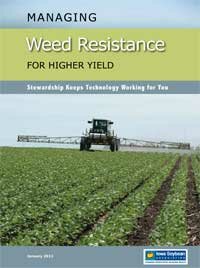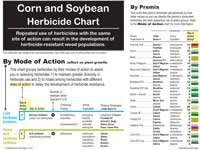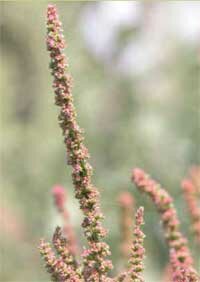
- Agronomics
-
Diseases
- Asian Rust
- Anthracnose
- Bacterial Blight
- Bacterial Pustule
- Bean Pod Mottle Virus
- Brown Stem Rot
- Cercospora Leaf Blight
- Charcoal Rot
- Downy Mildew
- Frogeye Leaf Spot
- Green Stem Syndrome
- Iron Deficiency Chlorosis
- Phytophthora Root & Stem Rot
- Powdery Mildew
- Rhizoctonia
- Seedling Diseases
- Septoria (Brown Spot)
- SCN (Soybean Cyst Nematode)
- Soybean Mosaic Virus
- Stem Canker
- Sudden Death Syndrome
- Viruses
- White Mold
- Pests
- Biological Control
- Diagnostic Tools
- About Us
- Library
Weed resistance to herbicides
 |
|
According to ISU weed scientist Mike Owen, farmers won’t realize they have a problem with herbicide resistance until about 30 percent of theweed population has the trait. See Managing Weed Resistance for Higher Yield: Stewardship Keeps Technology Working for You (pdf) |
 |
| Waterhemp seedlings can emerge throughout the growing season. |
Herbicide resistance is the inherited ability of a weed to survive and reproduce after exposure to a dose of herbicide that would normally be lethal.
In general, resistance develops through the natural selection of weeds exposed to a particular family of pesticides over a period of years. The resistant weed then has the genetic potential to pass along the resistant traits to future generations.
Each herbicide has a specific way in which it affects the weed plant. When resistance develops, it is to the particular mode of action of that herbicide.
Since the introduction of Roundup Ready® soybean in 1996, many growers have relied almost exclusively on Roundup and other herbicides containing the active ingredient glyphosate. Not surprisingly, resistance to glyphosate is now established in many weed species.
Populations of weeds resistant to other types of herbicides, such as ALS-inhibitors, ACCase inhibitors, and photosynthesis inhibitors are also increasing.
Control weeds and manage weed resistance
Implement a weed management program specific to the soil, tillage program, rotation schedule, and weed pressure in each field.
Integrate cultural, mechanical, and chemical weed control methods, and include the following:
- Rotate crops
- Mow or cultivate weedy escapes before they set seed
- Practice good sanitation to prevent the spread of weeds
- Rotate herbicide families and use herbicides with different modes of action
- Use herbicide mixtures with different modes of action
Determine herbicide mode of action
The active ingredient of the herbicide will be listed on the label. Use a herbicide mode of action chart to help you identify different materials. Be sure to rotate products with different mode of action within the season and between seasons, including the rotation crops.

|
| View herbicide mode of action chart (1MB pdf)» |
Knowing the herbicide mode of action also helps to diagnose herbicide injury.
A Corn and Soybean Herbicide Mode of Action chart was prepared by a group of soybean weed scientists. You can view the chart online in pdf format, or obtain a print copy from the Purdue University Media Store. Search for the Corn and Soybean Herbicide Chart.
View herbicide mode of action chart online (1MB pdf)»
Weeds at risk
Weeds that are most likely to develop resistance are annual weeds with high seed production and high germination rate, especially those that produce more than one generation in a year, or that are extremely sensitive to a particular herbicide.
 |
| A single waterhemp plant can produce more than 500,000 seeds. |
The weeds known to have developed resistance in the North Central region, and other areas of the country, include
| Cocklebur | Large crabgrass |
| Common lambsquarters | Shattercane |
| Common ragweed | Smartweed |
| Eastern black nightshade | Smooth pigweed and other pigweed species |
| Giant ragweed | Sunflower |
| Giant foxtail | Waterhemp |
| Green foxtail | Wild Carrot |
| Horseweed | Wild Oat |
| Kochia | Velvetleaf |

